Report Charts Climate Change’s Growing Impact in the US, While Stressing Benefits of Action
WASHINGTON—In a sprawling, multimedia report that stresses it is not too late to act, the Biden administration on Tuesday delivered a sobering catalog of climate change’s impacts in every corner of the United States—from battered coasts to parched cornfields to blazing forests. It measures the human toll, including at least 700 people dying of heat-related illness each year, in a nation warming 60 percent more quickly than the world as a whole.
“The effects of human-caused climate change are already far-reaching and worsening across every region of the United States,” the report says. But it adds that each increment of warming avoided through cutting carbon emissions will reduce the risks and harmful impacts.
“While there are still uncertainties about how the planet will react to rapid warming, the degree to which climate change will continue to worsen is largely in human hands,” the report says.
The Fifth National Climate Assessment, or NCA, is a peer-reviewed collaboration by more than 800 scientists from 14 federal agencies, universities and research institutions. It fulfills a mandate Congress put in place in 1990 for regular assessments of the risks of global climate change to the nation, meant to be delivered at least once in every presidential term.
And although the report does not make recommendations and is meant to be policy-neutral, it clearly carries the DNA of President Joe Biden’s administration: It emphasizes solutions being implemented as well as advances still needed. It delves into racial injustice and the jobs benefits of action. And it is packaged and digitally enhanced to deliver the message widely.
The rollout includes an interactive climate atlas, a podcast series, an artwork collection and a poem by U.S. Poet Laureate Ada Limón. Briefings for state and local policymakers will be held, zeroing in on regional impacts.
“Whatever we can do to get this into the hands of people who are making decisions across the country every day,” said Katharine Hayhoe, chief scientist at The Nature Conservancy, professor climate scientist at Texas Tech University and one of the report authors. “That’s what NCA is geared towards, so that we are prepared for and resilient to what the future holds.”
That contrasts sharply with the Fourth NCA, released by President Donald Trump’s administration over Thanksgiving weekend 2018 in an effort—its officials later admitted—to bury its findings.
Hayhoe, widely regarded as one of the nation’s leading science communicators, spoke at a webcast briefing for reporters that the White House organized in advance of the report’s release.
“Too many people still think of climate change as an issue that’s distant from us in space or time or relevance,” she said. “But NCA clearly explains how climate change is affecting us here, in the places where we live, both now and in the future, and across every sector of human and natural society.
“It shows us how if we live in the U.S., the risks matter, and so do our choices,” Hayhoe said.
The new NCA expresses certainty in the science of global warming in line with the assessments of the Intergovernmental Panel on Climate Change: “Human activities—primarily emissions of greenhouse gases from fossil fuel use—have unequivocally caused the global warming observed over the industrial era.”
Focusing on events that have upended life in the United States, the report details how science today has greater confidence in attributing them to climate change than in previous assessments. It says human-induced warming made the record-breaking Pacific Northwest heatwave of June 2021 2 to 4 degrees Fahrenheit hotter than it otherwise would have been, and made Hurricane Harvey’s deluge over Houston in 2017 15 to 20 percent heavier.
With the planet 2 degrees F (1.1 Celsius) warmer than it was in the late 1800s, the report says, “No natural processes known to science could have caused this long-term temperature trend. The only credible explanation for the observed warming is human activities.”
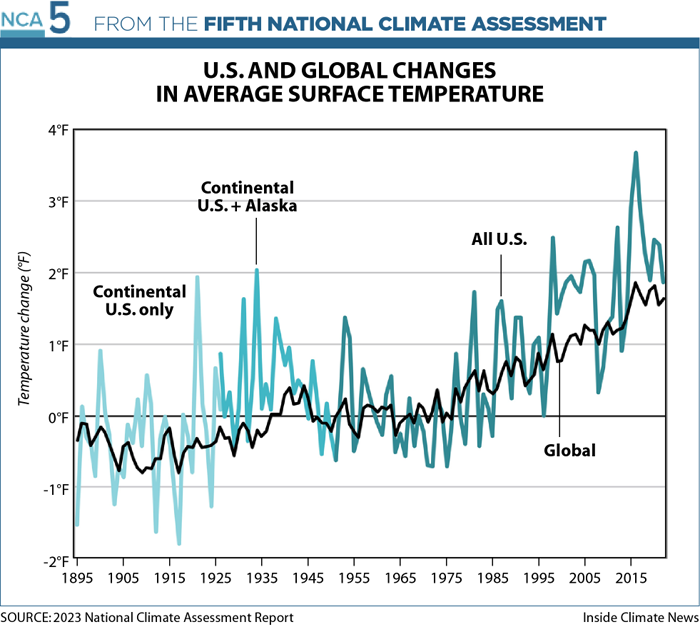
The United States is warming 60 percent more quickly than the global average, since land heats up more quickly than oceans—especially at higher latitudes. Alaska’s temperature has risen 4.2 degrees F ( 2.3 degrees C) since 1970, the report says, “transforming ecosystems, disrupting cultural practices, harming fisheries and other livelihoods, exacerbating health disparities, and placing infrastructure at risk.”
Between Optimism and Urgency
On solutions, the report walks a tightrope between optimism and urgency. The authors detail numerous state and local actions—a new stormwater code in Pittsburgh, for example, or water conservation efforts in the Southwest—but explain how more of these efforts have been undertaken to adapt to climate change than mitigate its increasingly harmful impacts. One chart shows that a majority of U.S. companies across all industries have committed to reducing greenhouse gas emissions, but also how low their implementation has been, particularly in reducing industrial process emissions.
The report sees an increasing shift to renewable energy because of lowered wind and solar costs and new policy support (mentioning Biden’s Inflation Reduction Act of 2022 by name), but concludes deployment would need to happen 2 to 10 times faster to fulfill the U.S. pledge of cutting economy-wide greenhouse gas emissions in half by 2030 and to net zero by 2050.
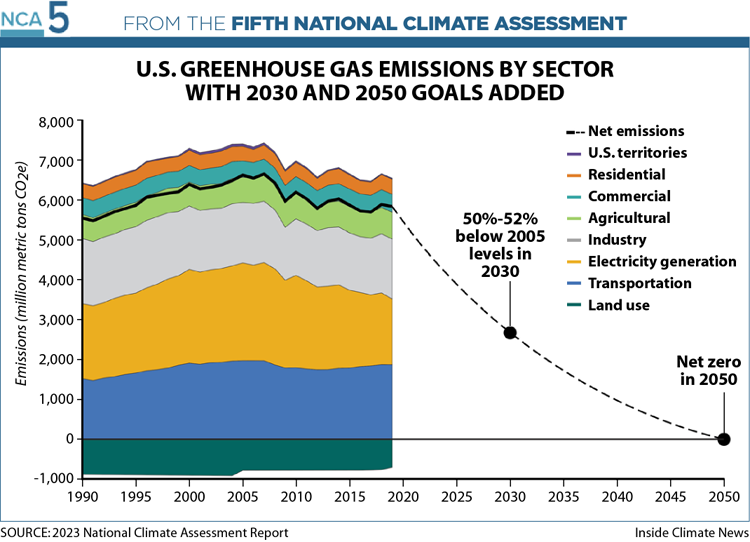
In tune with a theme Biden has sounded since his “Build Back Better” campaign in 2020, the report focuses on the economic opportunities of a clean energy transition in a way no previous NCA has done. Relying on 2021 Princeton University research, the report includes projections on how employment gains in electrification and renewable energy would outpace job losses in fossil fuel industries, moreso if the nation moves aggressively to 100 percent renewable power.
While the report expresses confidence that today’s renewable, storage and energy efficiency technologies can “immediately and substantially” reduce emissions, it says they are not enough: “The optimal mix of technologies to reach net-zero emissions is not yet clear, and further research and development is needed.”
A New Focus on Racial and Social Justice
The previous NCA, released during the Trump administration, sounded a dire warning about global warming only because of a battle waged by government scientists to maintain the project’s integrity, subsequent interviews have revealed. Although the NCA under the Biden administration reaches the same fundamental conclusion, the authors—freed of that internal fight—dug more deeply and looked more expansively at the complex mix of scientific and societal issues related to a rapidly warming climate.
To a degree not seen in previous reports, the NCA focuses on social and racial justice, with the authors delving into how historic racism and neighborhood redlining have worsened the climate peril for minority communities. With 700 to 1,300 deaths annually due to heat-related illness, the report notes fatalities for black Americans are at a rate twice that of the general population. Annual losses from flooding are projected to be close to double the national average in census tracts where black residents make up 20 percent or more of the population. The authors express confidence that a well-designed clean energy transition can help redress such inequities.
The NCA for the first time addresses “food systems,” looking not only at what is happening to crops in the field (corn yields falling 37 percent in some years and locations due to drought), but how climate change can affect every step of the food supply chain—from production, to storage, processing, distribution and consumption. It looks at worsening heat stress among farmworkers, food disruptions for subsistence-based peoples and how high food prices could undermine nutrition, particularly for low-income consumers. It is the first NCA to state that less meat consumption can reduce GHG emissions while providing direct health benefits.
For the first time, the Department of Homeland Security participated in the NCA, and the report addresses a broad range of international issues. In contrast to how the Trump NCA treated the national security implications of the melting of Arctic sea ice (“climate change is creating new transport opportunities“), the new report notes the potential for new emergency response needs and increased military activity, particularly by Russia. It is the first NCA to address the risks of reliance on China for the import of minerals needed for renewable energy technologies.
The report includes special sections on western wildfires, on Covid-19 and climate change, and on “compound events” such as the back-to-back storms that caused 55 deaths and more than $21.4 billion in damages in the Northeast in 2021.
At places in the report, the challenge for a multi-year project like the NCA to keep up with science, and with climate change itself, was apparent.
The report notes, for example, that compared to the 1980s, when in inflation-adjusted terms the country experienced one billion-dollar weather disaster every four months, there is now, on average, one every three weeks. But the pace has quickened to one every two weeks in 2023, with the National Oceanic and Atmospheric Administration logging 25 billion-dollar disasters in the year’s first 44 weeks.
In a year where dozens of climatologists, including former NASA scientist James Hansen, have called for accelerated research into technology for blocking the sun’s rays through dispersal of fine particles, the authors of the NCA said they would not consider “solar radiation management,” or SRM, as a mitigation technology in the report. “The effectiveness, costs, environmental trade-offs, and geopolitical implications of SRM are uncertain, and further research on these topics is either underway or may be merited,” they said.
That is in marked contrast with their treatment of other controversial technologies for producing hydrogen, both from fossil fuels and low-carbon processes, and for removing carbon from smokestacks and the atmosphere, which the authors explored more fully, while noting potential risks and high costs.
Hansen, now director of climate science, awareness and solutions at Columbia University’s Earth Institute, has made waves with a paper published too recently to be included in the NCA concluding that a major acceleration of warming is underway.
But Hayhoe said the authors of the NCA grappled with this question implicitly when they looked at high emissions scenarios, which include the assumption that warming will occur faster. “This idea is not new,” she said. “It has been baked into our analyses for years and even decades.”
So while the NCA’s baseline projection is that U.S. coastal sea levels, which have risen 11 inches in the past 100 years, will rise another 11 inches by 2050, the report notes that because of uncertainty regarding the stability of the Greenland and Antarctic ice sheets, increases of three to seven feet by 2100 and five to 12 feet by 2150 “cannot be ruled out.” The report notes that in the United States, relocation efforts have generally been reactive—like the targeted buyouts on Staten Island after Hurricane Sandy in 2012. In the future, the NCA said, proactive planned relocation—although “challenging and controversial”— may become the most viable response for many communities as coastal lands become submerged.
“One of the points that we really stress,” said one Biden administration official at the unveiling of the report, “is our society was built for a climate that no longer exists. And we need to reckon with that.”
Positive Trends on Energy, But Sharper Declines Needed
In a sharp break from the previous assessment, the new installment’s chapter on climate mitigation focuses on the ways the nation has begun cutting climate pollution and how those reductions now need to accelerate.
“We actually are making progress on the energy transition,” says Steven J. Davis, professor of earth system science at the University of California, Irvine and the chapter’s lead author.
While the nation’s greenhouse gas emissions were slightly higher in 2019 than they were in 1990, that masks a steady decline in recent decades, with climate pollution down 12 percent since 2005. The assessment uses 2019 data because of the “large but temporary changes” to energy use resulting from the Covid-19 pandemic, which drove a sharp decline in emissions and a subsequent rebound.
As positive as this trend is, however, the chapter says much sharper declines will be needed to meet the nation’s climate goals. So far, the cuts have been driven largely by replacing coal power generation with electricity made using natural gas, wind and solar energy. In the future, wind, solar and other emissions-free generation sources can provide steep, near-term gains in emissions but must be deployed at far higher rates than they have been.
By 2030, the report says, most modeling shows coal use falling to “near zero” unless power plants are fitted with carbon capture technology to all but eliminate the pollution coming from their smokestacks.
Improving energy efficiency will be critical, too. Modeling suggests that the nation’s total energy use can decline even as its population and economy continue growing. In transportation, for example, urban planning can reduce the need for driving by encouraging people to use public transit. Making passenger vehicles more efficient can further decrease emissions.
For some sectors of the economy, however, like heavy industry and long-haul trucking, the nation will need new and developing technologies such as hydrogen energy and carbon capture and storage. Modeling of electricity systems shows that building a resilient grid will require some form of long-duration storage or “firm” sources of generation that can be turned on and off on demand, the report says. Options include improved batteries and fitting fossil fuel power plants with carbon capture technology. It remains unclear what the optimal mix of these technologies will be, Davis says, but there is time to figure that out.
“It’s almost like, that’s the last 20 percent of the problem,” Davis says, “and we have another 80 percent to go before we need to worry about it.”
The nation will also need to start removing significant amounts of carbon dioxide from the sky in coming decades, the chapter says, though that could be achieved through a wide array of methods. Most modeling suggests that “direct air capture” technology—using machinery similar to carbon capture to pull CO2 from the sky—will play only a small role due to high costs. Other options, including “rewetting” drained wetlands and new agricultural techniques, could prove far cheaper. In some cases, the report says, it could be cheaper to continue burning fossil fuels in a small number of applications, such as aviation, while using these carbon removal methods to offset the resulting pollution.
Some “natural solutions” to climate change could face challenges as the climate continues to warm. One troubling trend highlighted in the chapter is that the nation’s forests have been removing significantly less carbon dioxide from the air—about 20 percent less in 2019 than 1990—as wildfires, droughts and diseases have killed countless trees. A warming climate, in other words, is undermining forests’ ability to absorb carbon and lessen the impacts of fossil fuel pollution.
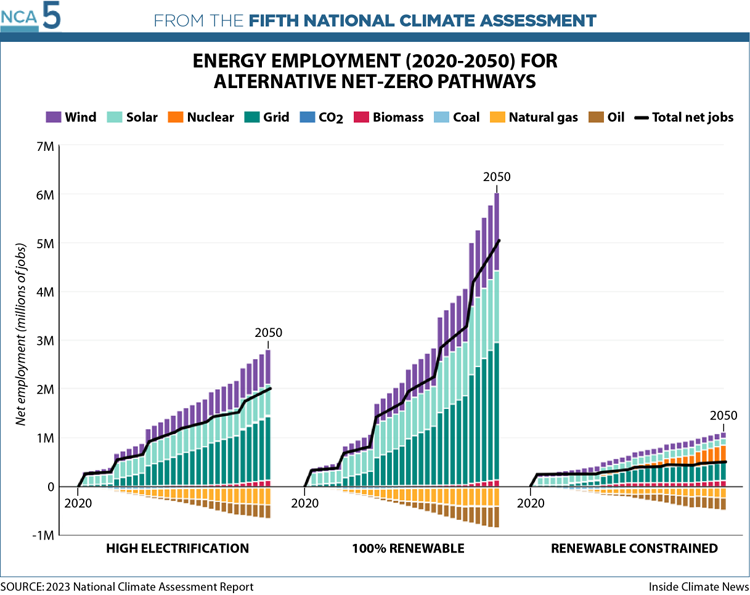
If the nation can take effective action to limit emissions, the chapter says, the benefits would spread far beyond limiting warming. Cleaner air would help prevent 200,000 to 2 million cumulative deaths by mid-century, it says, while widespread deployment of renewable energy could create millions of jobs.
Global Interdependencies
America’s national interests are increasingly affected by climate impacts and responses—from extreme weather to changes in how energy is produced—that are happening beyond our national borders.
Since 2018, more research has focused on U.S. competition with China over key metals and minerals for clean energy technologies, and a melting Arctic region is creating new shipping lanes, resource extraction opportunities and raising the specter of conflict with Arctic powers including Russia.
The United States has long known that the warming planet is driving changes to U.S. troop missions, humanitarian assistance and American companies’ global supply chains. But increasingly those issues are interacting with each other in ways not fully understood.
One of the report’s many examples of complex climate interactions focuses on Central America, where millions of families are deeply reliant on “climate-sensitive agriculture.” Climate amplified droughts and storms in that region have inflamed existing conflict and insecurity, which are contributing to unprecedented levels of migration toward the U.S. border.
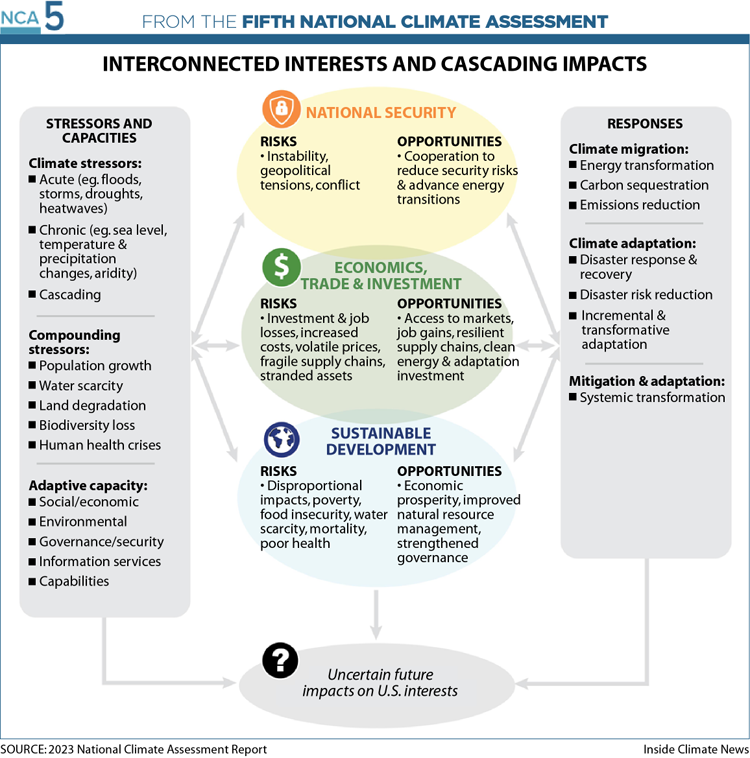
“Researchers are increasingly looking at global interdependencies and how climate impacts that happen in one part of the world can cause disruptions in global security, economic trade and human welfare, similar to what we saw with COVID-19,” said Molly Hellmuth, senior technical director of climate at Winrock International and the lead author of the report’s international chapter.
Hellmuth and her coauthors paint a stark portrait of the toll climate change is taking on the world’s most vulnerable. Approximately 26 million people fall into poverty annually due to extreme weather events, like Pakistan’s climate-fueled flooding earlier this year, and global warming is expected to significantly increase mortality in the Global South in the coming decades, exacerbating inequalities and affecting people whose countries have contributed the least to the problem. Ensuring that developing countries adapt to climate change isn’t just a strategic U.S. interest touching on security, moral and economic realms—it’s also an opportunity for American businesses to pioneer new solutions and technology, the report says.
Geoff Dabelko, a professor at Ohio University and report co-author, said the assessment indicates that climate impacts and actions overseas are key to U.S. climate change outcomes. “Americans are fundamentally interdependent with the rest of the world,” he said.
Devastating Consequences for Biodiversity
Climate change has undoubtedly altered ecosystems in the U.S., from Florida’s once-bustling coral reefs to Washington’s iconic forests. These climate-fueled shifts will continue to have devastating consequences for biodiversity and, as a result, the services that ecosystems provide humanity, according to the new report.
“For me, it’s about understanding how dependent we are on ecosystems, and when they change, that blows back onto us,” said Pamela McElwee, environmental social scientist at Rutgers University and a lead author on the NCA report. “Without sort of having our political and economic systems keep pace with the speed at which our ecosystems are changing, we’re falling further and further behind.”
For certain species, temperature rise has created unsuitable habitat conditions, causing them to move into new areas. This is particularly true for large-bodied animals, the report says, including North Atlantic right whales, which are traveling to new areas to find food where they are unprotected and vulnerable to threats such as vessel strikes. Other species may not be able to outrun the rapid changes in their habitat and could simply die off. In Alaska, 10 billion snow crabs disappeared between 2018 and 2021, likely as a result of marine heatwaves, which left the crustaceans without enough food, researchers say. These types of losses can have massive implications for people in fishing and agricultural industries who depend on ecosystems for their livelihoods.
In extreme cases, climate change can drive complete—and sometimes irreversible—transformations to an ecosystem, altering its structure, function and the composition of species that depend on it, the report outlined. For example, in the Arctic, warming and climate-fueled fires are causing permafrost to rapidly thaw. This frozen soil contains excess ice within its pores, so if it thaws, the ice can melt and cause the ground to collapse.
“Even if you refroze that, it’s that physical change has already happened, and so it’s not going to go back to what it was,” McElwee said. “With permafrost, in addition to the ecosystem itself changing, it’s releasing carbon as a result of the rising temperatures and so it’s sort of a double whammy.”
To help buffer species against climate-driven impacts, states must help restore and protect ecosystems so that species can recover from extreme weather events or poor breeding seasons, the report’s authors wrote. Restoring nature can also help protect humans from certain climate impacts; for example, coral reefs provide estimated adaptation benefits of more than $1.8 billion annually, according to the report.
Ocean Impacts Threatening Lives and Livelihoods
The world’s oceans are experiencing a suite of climate-driven changes, from rapid warming to oxygen loss to acidification. As these impacts unfold, threats against coastal and ocean-dependent communities are proliferating as well, the report says.
Over the next 30 years, sea levels are expected to rise by about 11 inches in coastal areas along the contiguous U.S., or even higher in some regions. Coupled with storm surges and a higher risk of hurricanes, this rise could cause severe flooding near shorelines, with tribes and Indigenous peoples, rural communities and low-income neighborhoods facing the brunt of the impact, according to the report.
Compounding the problem, the construction of seawalls and levees can “exacerbate flood risks and erosion and affect the ability of coastal ecosystems to naturally adapt,” the report’s authors write. Coastal development is also negatively impacting wetland ecosystems such as mangroves, which could provide natural buffers against flooding. While greater investment in urban planning and protection or restoration of wetland ecosystems could help mitigate flood risk, some communities may be forced to retreat from their homes altogether as sea-level rise accelerates—a strategy known as planned relocation.
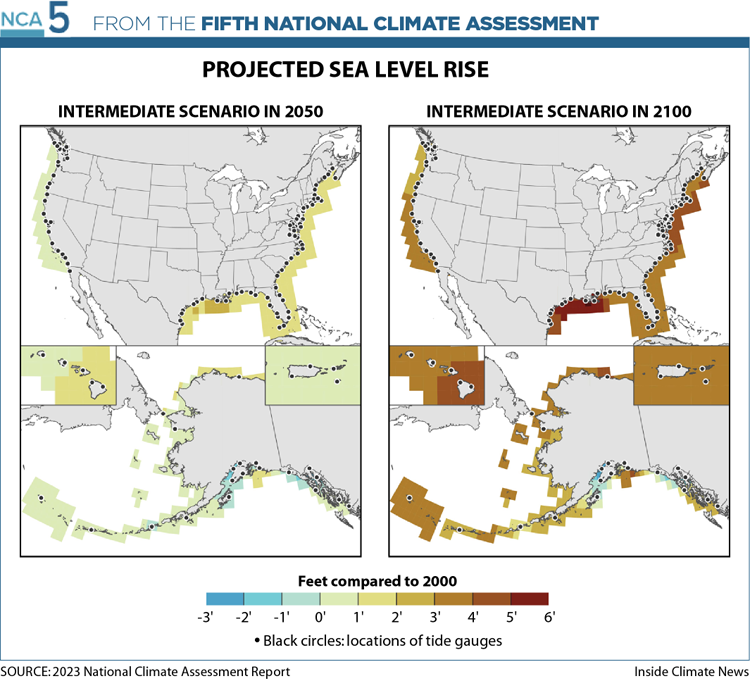
Climate-fueled ocean impacts are not only threatening lives, but also livelihoods, according to the report. The ocean is a hub for industry in the U.S., with revenue from fishing, recreation and tourism, energy, shipping and transportation in the sea and Great Lakes employing millions and contributing more than $781 billion to the economy in 2021. But a deadly combination of long-term ocean changes and short-term extreme events, such as marine heatwaves, are collapsing aquatic food chains around the country. Climate change is projected to reduce catch for some of the highest-valued fisheries, including Bering Sea snow crab, walleye pollock and Pacific cod, in every region of the U.S. over the next century, resulting in billions of dollars in losses, according to the report.
Federal and state governments, along with industry, must increase efforts to monitor changes in oceans so that fisheries and other ocean-dependent industries are not caught flat-footed in the face of marine heatwaves or extreme weather events, the report’s authors write.
“We are only just beginning to be able to pick up the chronic changes, not extreme changes, but subtle changes in systems and fisheries and so on,” said Charles Cogan, a co-author of the report who is research director of the Center for the Blue Economy at Middlebury College’s Institute of International Studies at Monterey, formerly the Monterey Institute of International Studies.
The report is “a warning that in the ocean at least, there are so many things that we don’t observe on a regular basis,” he added, “that it’s going to be easy for the effects of climate change on oceans to sneak up on us.”
Share this article
Disclaimer: The copyright of this article belongs to the original author. Reposting this article is solely for the purpose of information dissemination and does not constitute any investment advice. If there is any infringement, please contact us immediately. We will make corrections or deletions as necessary. Thank you.







